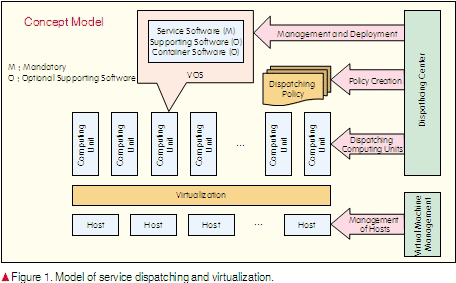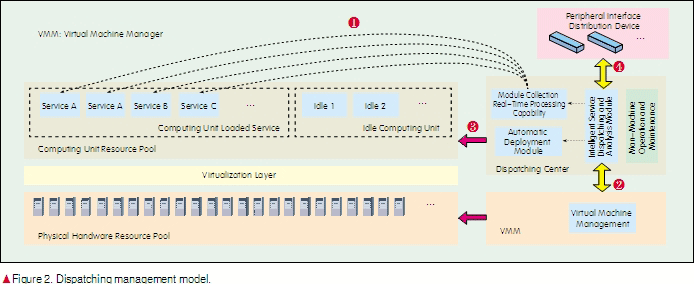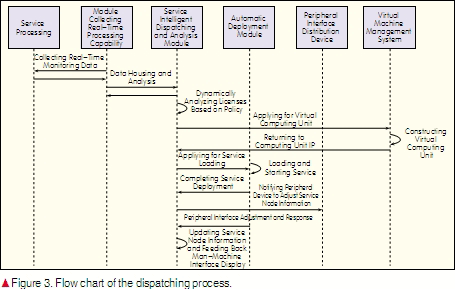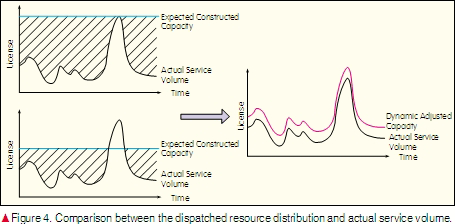Cloud Computing in Mobile Communication Networks
1 New Requirements in the Communication Industry
With the development of 3G networks, more service platforms are being deployed by carriers. In addition to the widely-used WAP/WEB gateway and Short Message Center, Multimedia Messaging Center, new service application platforms will emerge as services are developed. Regardless of service functions and office size, an independent construction mode is used for current service platforms.
For service products of different companies, modules such as billing management module, user management module, configuration management module, maintenance management module, and log/report module are similar. Only the core service processing modules are different. Modules can be integrated using specific methods. For the core processing part of each service, the service logics are different, and the process is complicated. Therefore, capabilities cannot be shared in the service layer. The dispersive construction mode of multiple services creates barriers for the rapid development of the mobile communication industry. The causes are as follows [1]-[4]:
- The types of purchased software and hardware used by each service platform are different. The service interruptions and system faults caused by the purchased parts are hard to control or prevent.
- The maintenance methods provided by different service platforms are different. Carriers have to train many technicians for system maintenance. This training increases maintenance costs.
- The service platforms are constructed independently. The loads in different regions and service processing capabilities are not equal. Use of the constructed hardware resources is low.
Only virtualization technology does not provide service-level flexibility to invoke and control. The following describes a total solution to service dispatching and virtualization. In this solution:
- The service can obtain computing resources according to the actual processing requirements. The carrier need not estimate computing resources before providing a service. This eliminates the risks of pre-investment, and a service can be started on a small scale. With an increase in demand, hardware resources occupied by services can be expanded through service dispatching and virtualization technology.
- The problem of service imbalance in different regions and at different times is solved. Hardware power consumption is reduced when the service volume is low. By expanding hardware resource occupation during holidays or for unexpected service peaks, operational risk is avoided.
- Many mobile network resources can also be rented externally. After the computing resource is virtualized, charges are paid quickly. The tenant can use the computing resource on demand.
2 Service Dispatching and Virtualization
Based on the urgent requirements of mobile carriers, this article provides a total solution that integrates virtualization and service dispatching. The model architecture is shown in Fig.1.

The core management components include a virtual machine management system and a service dispatching center. In the schematic design, bottom-layer physical device virtualization and service-layer processing capability are separate.
An application requires a computing mode, a storage mode, and a communication mode. For flexibility and unlimited mirroring of the computing resource, the most practical method is virtualization of resources. The multiplexing and sharing mechanisms are hidden for applications. Different public computing is distinguished according to the abstractness and management layer.
In this scheme, the mobile communication service computing cloud is managed in two layers. In the first layer, physical hardware is virtualized to an abstract computing unit. The process is not affected by upper layer services. The attributes of all computing units are consistent. The second layer is the dynamic dispatching system for the differential service. Flexibility control for the service system can be implemented according to different service processing logics, service performance requirements, and expected resource occupation. With the cooperation of the service dispatching center and virtual machine management center, the requirements of multiple-service real-time dynamic resource adjustment are met.
At present, virtual machine technology is sophisticated. Most mainstream virtual machine factories construct hardware CPU and memory virtual units through XEM and KVM technologies. Virtual machine technology has the following four features:
- It runs multiple virtual units on a single physical server
- Virtual units are mutually separated on a virtual machine of the same physical hardware device
- The complete virtual unit is saved in the file. The virtual unit is moved and copied by moving and copying these files
- The relationship between the virtual unit and bottom layer physical hardware is shielded. Smooth migration can occur on any server without any modification.
Virtualization technology converts physical resources into a resource pool that is easy to divide. In its design, virtual technology complies with the conditions of cloud computing and is capable of universal resource dispatching. The resource to be dispatched is not limited to the virtual unit only. Mobile carriers require a solution that provides centralized capability control for different services. In this solution, dynamic service traffic of multiple services can be monitored, and service load can be determined intelligently. Then, hardware and virtual unit resource dispatching can be balanced.
By constructing service dispatching module based on virtual machine technology, shortage of the control over the communication service in the technology can be covered. The dispatching center works with the virtual machine management system to complete dispatching. The model is show in Fig. 2.

Four functional modules are contained in the dispatching center. They are:
- service intelligent dispatching and analysis module. As the core processing module of the dispatching center, the module analyzes the processing capability of the service layer and adjusts the service licenses according to real-time monitored and collected service running data. When necessary, it applies for an idle computing unit or releases an occupied redundant computing unit by interacting with a virtual machine management system. Services are quickly loaded and unloaded through automatic deployment of modules to dynamically adjust the service license processing capability. At the same time, the module is also responsible for notifying the peripheral interface distribution devices of the service node flexibility.
- real-time processing capability collection module. By interacting with the service processing, this module collects information such as real-time message processing traffic, database resource occupation requirements, and processing capability. Two collection modes are supported: Scheduled service process reporting mode and dispatching sub-system sent message initiative driving mode. The collected data is written into the dispatching analysis database for intelligent dispatching policy analysis.
- automatic deployment module. This module loads the service packets into the specified computing unit according to the deployment message of the service-intelligent dispatching and analysis module. Or it stops the service to clear the service packets from the computing unit.
- man-machine maintenance. This provides man-machine operation interface. The service module running status can be monitored, and manual interference with the dispatching is provided.
The dispatching center implements dynamic adjustment and resource multiplexing for processing the mobile communication service. It does this through cooperation between the modular structure and virtualization management platform. The detailed procedure is shown in Fig. 3.

Service license flexibility is dynamically controlled by tracing and monitoring the actual service volume of the service processing unit. It is also controlled by tracing and monitoring the dispatching policy and threshold configured in the intelligent dispatching and analysis center.
The intelligent dispatching and analysis policy includes [5]-[7]:
- a disaster-tolerant dispatching policy that checks whether other service processing units can share the workload of the service node if the service processing unit is abnormal. It applies for a new virtual computing unit to take over the original service processing to ensure stable running of the system.
- a periodic hibernation policy that determines periodic adjustments according to the service traffic. It releases and applies for a computing unit according to regularity. For quick start, stop, and switch, the released computing unit can retain the original service program. Hibernation and activation are implemented in status to save energy.
- a service development adjustment policy that determines whether occupation of computing resources should be increased or decreased. It makes this determination based on the actual condition of the service development and complete automatic loading and unloading of services.
These three polices are implemented through the core component—the intelligent dispatching and analysis module of the dispatching center. This module is responsible for controlling virtual resources according to the monitored data. No-interference dynamic adjustment requires a number of comparison algorithms to evaluate multiple indexes. A resource dispatching command is sent according to the evaluation results [8]. A universal computing model is as follows:
1) Sampling condition
- Sampling interval: 1 s
2) Sampling data
- The processing license of the sampling point virtual unit bearing "service type 1" is: Llic
- The sampling point virtual unit occupied CPU is: Lcpu
- The sampling point virtual unit occupied memory is: Lmemory
- The sampling point virtual unit occupied Input/Output (I/O) resource is: Lio
The weights of the parameters in the computing are R1-R4. The weight indicates the occupied resource offset in the computing unit of different service applications [9]. If the coefficient Ri (R1-R4) cannot reflect the load of applications, it is modified until more accurate values are found [10]-[12].
3) Calculation formula of the sampling value
LOAD(Ni)= R1x Llic (Ni)+R2 x Lcpu(Ni)+R3 x Lmemory(Ni)+R4 x Lio(Ni)
4) Determination period and method
Comprehensive determination of the weighted loading values can be made using consecutive sampling. When setting the cycle of the collected weight values, short cycle more accurately reflects the instant loading of each computing unit. Frequent collection increases the burden on the tested computing unit or increases unnecessary network load [13]. To solve this problem, the cycle for collecting load information can be adjusted (10-15 seconds is recommended). At the same time, the slide window can be used to prevent jittering of the sampling data.
5) Dispatching policy:
A comparison is made based on the collected periodic sampling data and the loading section of the virtual unit to determine the load of the computing unit and then take relevant dispatching policy. The requirements for constructing flexible service platforms are met using the dispatching center and a virtual machine scheme. As a result, CAPEX and OPEX are reduced, investment is saved, and greater profit is obtained.
3 Conclusions
At present, service platforms of mobile communication networks are constructed independently. In the early stages of investment and construction, carriers usually evaluate the scale of their service platforms based on the predicted maximum service peak in holidays. Even though these predictions are usually accurate, a certain amount of investment is also wasted. If the peak value is under-estimated, the configuration may be insufficient. Service requests of excess users may be rejected, and these rejected users will not bring in any revenue. Users may also lose confidence and refuse to use the service again because of the poor service experience.
As shown in Fig. 4, dynamic dispatching of the service layer and the application of virtualization technology enable resource distribution to consistent with the service volume curve.

Service dispatching and virtualization discussed in this article is an optional scheme for mobile communication network clouding. The scheme has the following features:
- Unlimited cloud computing resources are obtained. Cloud computing users do not need to plan for computing resources long before the service provision.
- Prior investment of cloud users is not necessary. A service can be started on a small scale, and hardware resources can be expanded with development requirements.
- Computing resources can be used on demand in short time. Resources can be released when they are not required. Idle machines and storage units are released and costs are saved.
Service dispatching and virtualization technology provides an idea and method for bringing cloud computing to mobile computing. The author believes that service dispatching and virtualization technology will gradually become the main construction mode of the mobile communication industry.
References
[1] M. Armbrust, A. Fox, R. Griffith, et al, “Above the clouds: A Berkeley view of cloud computing,” Dept. Elect. Eng. Comput. Sci.,Univ. California, Berkeley, Tech. Rep. UCB/EECS-2009-28, 2009.
[2] Amazon.com CEO Jeff Bezos on Animoto. [Online]. Available: http://blog.animoto.com.
[3] M.A. Vouk, “Cloud Computing-Issues, research and implementations,” Proc.30th Int. Conf. on Inform. Techn. Interfaces (ITI’08), Dubrovnik, Croatia, 2008, pp.31-40.
[4] L. Barroso, U. La Holzle, “The case for energy-proportional computing,” IEEE Computer, vol.40, no.12, pp.33-37, Dec.2007.
[5] Dean J, Ghemawat S, “MapReduce: Simplified data processing on large clusters,” Proc.6th USENIX Symp.Operation Syst. Design and Implementation (OSDI'04), San Francisco, CA, 2004, p.10.
[6] W. M. Bulkeley W M. (2007, Oct. 8). “Universities Combine ‘Cloud’ Forces.” Wall Street Journal [Online]. Available: http://uwnews.washington.edu/ni/apps/dailyclips/scraped/WSJ_2007-10-08.html
[7] A. Demers, K. Petersen, M. Spreitzer et al, “The Bayou architecture: Support for data sharing among mobile users,” Proc.1st IEEE Workshop on Mobile Comput. Syst. Applic. (WMCSA’94), Santa Cruz ,CA,1994, pp.2-7.
[8] S. Garfinkel, “An evaluation of Amazon’s grid computing services: EC2, S3 and SQS, ” Comp. Sci. Group, Harvard Uni., Rep.TR-08-07.
[9] S. Ghemawat, H. Gobioff, S. Leung et al, “The Google file system,” Proc.19th ACM SIGOPS Symp.Operating Syst.Principles (SOSP’03), New York, 2003, pp. 29-43.
[10] J. Gray, Distributed Computing Economics, New York: ACM Press, 2008, pp.63-68.
[11] J. Gray, D. Patterson, Conversation with Jim Gray, New York: ACM Press, 2003, pp.8-17.
[12] J. Hamilton. (2008, Nov. 28). “The cost of power in large-scale data centers,” [Online]. Available: http://perspectives.mvdirona.com/2008/11/28/CostOfPowerInLargeScaleDataCenters.aspx
[13] J. Hamilton, “Internet-scale service efficiency;” Proc.2nd Workshop on Large-scale Distributed Systems and Middleware (LADIS'08), New York, 2008.
[Abstract] Cloud computing makes computing power universally available and provides flexibility in resource acquisition. It allows for scalable provision of services and more reasonable use of resources. This article considers cloud service deployment and virtualization from the perspective of mobile operators. A solution is proposed that allows mobile operators to maximize profits with minimal investment.
[Keywords] resource sharing; service deploy; virtualization